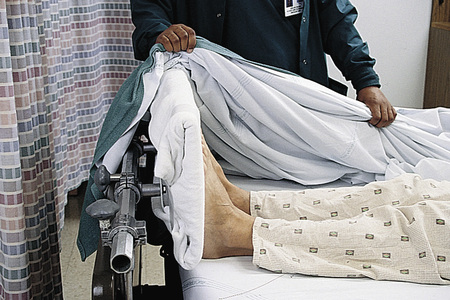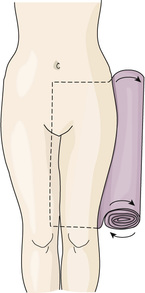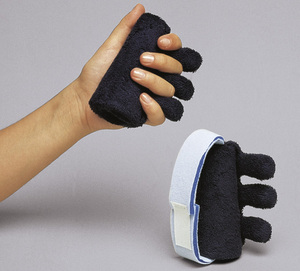Exercise and Activity
Objectives
• Define the key terms and key abbreviations in this chapter.
• Explain how to prevent the complications from bedrest.
• Describe the devices that support and maintain body alignment.
• Explain the purpose of a trapeze.
• Describe range-of-motion exercises.
• Perform the procedures described in this chapter.
• Explain how to promote PRIDE in the person, the family, and yourself.
Key Terms
Most people move about and function without help. Illness, surgery, injury, pain, and aging cause weakness and some activity limits. Inactivity, whether mild or severe, affects every body system and mental well-being.
You assist the nurse in promoting exercise and activity in all persons to the extent possible. Physical and occupational therapists help the person improve strength and endurance. Care plan goals may be to improve independence so the person can go home. Or the goal may be to attain the highest level of function possible. The care plan and your assignment sheet include the person’s activity level and needed exercises.
See Focus on Children and Older Persons: Exercise and Activity, p. 514.
Bedrest
The doctor orders bedrest to treat a health problem. Or it is a nursing measure if the person’s condition changes. Bedrest is ordered to:
These types of bedrest are common.
• Bedrest with commode privileges. The commode is used for elimination.
• Bedrest with bathroom privileges (bedrest with BRP). The bathroom is used for elimination.
The person’s care plan and your assignment sheet state the activities allowed. Always ask the nurse what bedrest means for each person. Ask the nurse if you have questions about a person’s activity limits.
Complications From Bedrest
Bedrest and lack of exercise and activity can cause serious complications. Every system is affected. Pressure ulcers, constipation, and fecal impaction can result. Urinary tract infections and renal calculi (kidney stones) can occur. So can blood clots (thrombi) and pneumonia (inflammation and infection of the lung).
The musculo-skeletal system is affected too. For normal movement, you must help prevent the following.
• A contracture is the lack of joint mobility caused by abnormal shortening of a muscle. The contracted muscle is fixed into position, is deformed, and cannot stretch (Fig. 30-1). Common sites are the fingers, wrists, elbows, toes, ankles, knees, and hips. They can also occur in the neck and spine. The site is deformed and stiff.
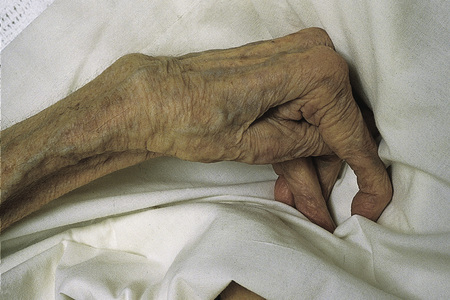
• Atrophy is the decrease in size or the wasting away of tissue. Tissues shrink in size. Muscle atrophy is a decrease in size or a wasting away of muscle (Fig. 30-2).
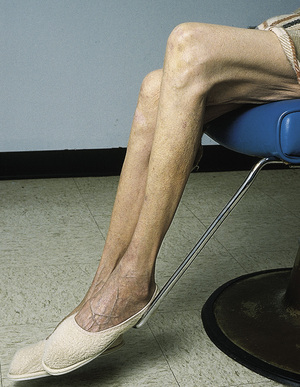
Orthostatic hypotension is abnormally low (hypo) blood pressure when the person suddenly stands up (ortho and static). When a person moves from a lying to sitting to standing position, the blood pressure drops. The person is dizzy, weak, and has spots before the eyes. Syncope can occur. Syncope (fainting) is a brief loss of consciousness. (The Greek word synkoptein means to cut short.) Orthostatic hypotension also is called postural hypotension. (Postural relates to posture or standing.) Box 30-1 lists measures that prevent orthostatic hypotension. Slowly changing positions is key.
Good nursing care prevents complications from bedrest. Good alignment, range-of-motion exercises (p. 517), and frequent position changes are important measures. These are part of the care plan.
See Focus on Communication: Complications of Bedrest.
Positioning
Body alignment and positioning were discussed in Chapter 17. Supportive devices are often used to support and maintain a certain position.
• Bed-boards—placed under the mattress to prevent it from sagging (Fig. 30-3). The bed-boards are covered with canvas or other material. Bed boards are used more often in home settings.
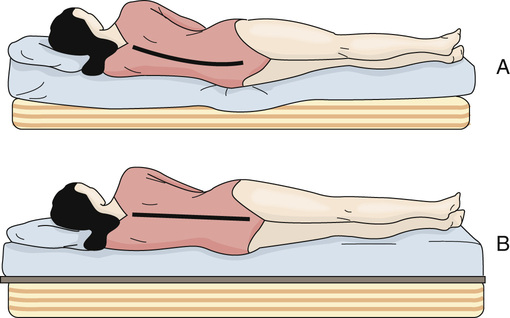
• Foot-board—prevents plantar flexion that can lead to footdrop. In plantar flexion, the foot (plantar) is bent (flexion). Footdrop is when the foot falls down at the ankle (permanent plantar flexion). The foot-board is placed so the soles of the feet are flush against it (Fig. 30-4). Foot-boards also serve as bed cradles by keeping top linens off the feet and toes.
• Trochanter roll—prevents the hips and legs from turning outward (external rotation) (Fig. 30-5, p. 516). A bath blanket is folded to the desired length and rolled up. The loose end is placed under the person from the hip to the knee. Then the roll is tucked alongside the body. Pillows or sandbags also keep the hips and knees in alignment.
• Hip abduction wedge—keeps the hips abducted (apart) (Fig. 30-6, p. 516). The wedge is placed between the person’s legs. The device is common after hip replacement surgery.
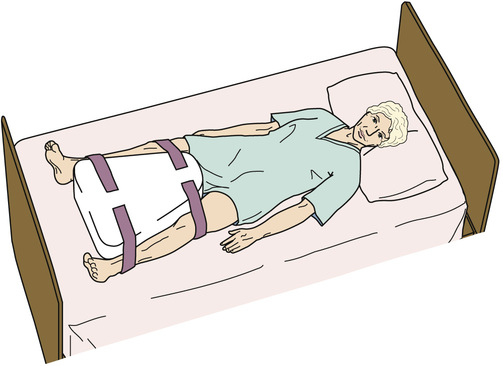
• Hand roll or hand grip—prevents contractures of the thumb, fingers, and wrist (Fig. 30-7, p. 516). Foam rubber sponges, rubber balls, and finger cushions (Fig. 30-8, p. 516) also are used.
• Splints—keep the elbows, wrists, thumbs, fingers, ankles, or knees in normal position. They are usually secured in place with Velcro (Fig. 30-9, p. 516).

• Bed cradle—keeps the weight of top linens off the feet and toes (Fig. 30-10, p. 516). The weight of top linens can cause footdrop and pressure ulcers.
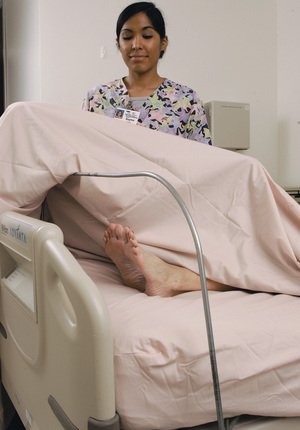
Exercise
Exercise helps prevent contractures, muscle atrophy, and other complications from bedrest. Some exercise occurs with ADL. Other exercises are needed for muscles and joints. (See “Range-of-Motion Exercises” and “Ambulation,” p. 522.)
A trapeze is used for exercises to strengthen arm muscles. The trapeze hangs from an over-bed frame (Fig. 30-11). The person grasps the bar with both hands to lift the trunk off the bed. The trapeze is also used to move up and turn in bed.
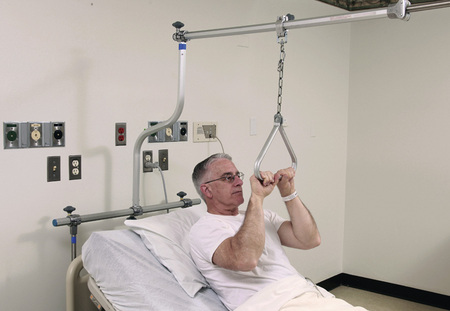
 Range-of-Motion Exercises
Range-of-Motion Exercises
The movement of a joint to the extent possible without causing pain is the range of motion (ROM) of the joint. Range-of-motion exercises involve moving the joints through their complete range of motion (Box 30-2). They are usually done at least 2 times a day.
• Active ROM exercises—are done by the person.
• Passive ROM exercises—you move the joints through their range of motion.
• Active-assistive ROM exercises—the person does the exercises with some help.
Bathing, hair care, eating, reaching, dressing and undressing, and walking all involve joint movements. Persons on bedrest need more frequent ROM exercises. So do those who cannot walk, turn, or transfer themselves because of illness or injury. The doctor or nurse may order ROM exercises.
See Focus on Communication: Range-of-Motion Exercises.
See Focus on Children and Older Persons: Range-of-Motion Exercises, p. 518.
See Focus on Long-Term Care and Home Care: Range-of-Motion Exercises, p. 518.
See Delegation Guidelines: Range-of-Motion Exercises, p. 518.
See Promoting Safety and Comfort: Range-of-Motion Exercises, p. 518.
See procedure: Performing Range-of-Motion Exercises, p. 519.
Stay updated, free articles. Join our Telegram channel

Full access? Get Clinical Tree


